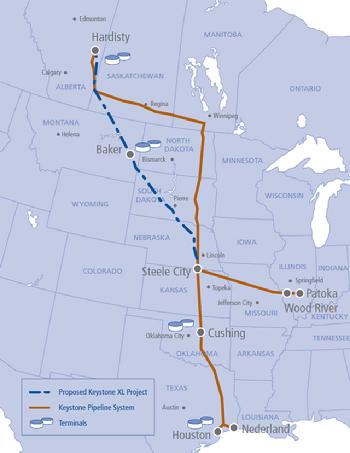|
 |
| Keystone Pipeline and Hydrocarbon Wars - what it means... |
|
|
|
| War Against Keystone Pipeline and Hydrocarbons Ended? |
Perspective: War Against Keystone Pipeline and Hydrocarbons Ended?
Brian Blazina, Energy Resource Americas (ENRAM)
March 28, 2017 (last updated)
Chicago - TransCanada's Keystone XL Pipeline project to transport heavy tar sands crude oil from Canada to the U.S. Gulf Coast and Illinois, has been in the works for nearly a decade, half that time tied up in political delay with some stakeholders set on stopping the project in an environmental war on hydrocarbons, and some angry landowners. On January 24, 2017, in his second day in office, President Trump signed an executive order moving the project forward.
The President also signed an executive order advancing the Dakota Access Pipeline, and a third executive order requiring all U.S. pipeline projects to use U.S. made pipe. ENRAM estimates these actions slightly, and temporarily, benefit U.S. investment, and employment, while minimally lowering world crude oil prices, U.S. refinery input costs, and U.S. refined product prices such as gasoline, diesel and jet fuel.
We project the actions may raise pipeline project costs, but incentives and speedy project approvals may offset these higher costs. Like most things in high demand, the economics of tar sands oil was never stopped, but merely slowed down, however long the delay. In the view of some "experts", longer delays help raise world crude oil prices further, making tar sands crude oil more valuable due to tar sands' lower netback cost. So what does this mean for Keystone and Hydrocarbons?
However, the long wait led to other creative solutions like unit trains moving tar sands oil from Canada to the U.S., that may threaten the need for the XL pipeline shortcut.
...tens of thousands of pipelines have been built in the US
over the last 50+ years, with little fanfare. Why is Keystone
so different? The reason may be the renewed effort to
attack hydrocarbons as a source of global climate change
From strictly a world and U.S. economics perspective, the new XL pipeline may help reduce world crude oil prices by bringing additional supply to market, and provide billions in U.S. investment and thousands of temporary construction jobs. Some of that tar sands oil should make its way into U.S. refineries spurring billions in investment. On the down side, not realizing these economic benefits, and poking Canada, our #1 trading-partner, with a stick in the eye was always a potential diplomacy mistake not easily forgotten. At some point in time we were going to help our largest trading partner. TransCanada had already indicated plans to re-apply for the project almost immediately after President Trump approved the project, and as of March 27, 2017, the President issued the permit to finish the XL Pipeline.
However, TransCanada should have dealt with politicians, landowners, and environmentalists in a more proactive manner, such as adding more U.S. manufactured pipe; using more U.S. suppliers; contracting U.S. firms specialized in landowner negotiations; and re-routing the pipeline around the Nebraska water reservoir. They still can do that today, just as Sohio accommodated various special interest groups when building the Trans Alaskan Pipeline System - such as building in room under the pipe for animal crossings, among hundreds of other custom construction changes to ease concerns raised by environmentalists, native Americans, Alaskans, and government officials.
Tar sands crude oil is already traversing throughout the U.S. on old converted and reversed pipelines, and by rail car – both higher environmental and safety risks than a new pipeline, proven in a number of old pipeline and rail incidents including residential neighborhood pollution and railcar accidents. So the delays have actually raised pollution and safety risk in the U.S. and Canada. We had another tar sands crude oil train derailment in Canada that burned a city center.
So the longer we delayed bringing the lower cost tar sands oil to market, the higher the realized safety and environment risks - contrary to the goals of environmentalists, one would think. Real consequences from a number of incidents. The XL Pipeline also delays Peak Oil Production, higher energy costs, and price volatility. Alternatives exist to the XL Pipeline - some already up and running, and negatively impacting the project economics. However, estimated impacts and events are difficult to forecast in this theoretical realm with many moving parts.
|
 |
| Keystone XL Pipeline route, source: TransCanada |
|
|
 |
| Click above for FREE OFFER |
|
|
The argument that the tar sands crude oil will only be transported to the U.S. Gulf Coast and shipped out of the U.S. - bringing no value to the U.S. - is simply not true. Billions of U.S. dollar investments have been made in U.S. refineries over the last decade to run the heavy crude oil, like the tar sands. So as much tar sands volume as economically feasible, will run in U.S. refineries, because lower cost inputs means higher margin outputs. Finished product manufacturing benefits U.S. investment in manufacturing, infrastructure, etc., meaning thousands of jobs for refinery workers, engineering firms, consultants, and temporary XL Pipeline workers. Alternative routes existed through western and eastern Canada, that would have provided little investment or jobs in the U.S. Heavy crude oil comes from Mexico and Venezuela, too, creating surplus heavy oil beyond the capacities of the U.S. Gulf Coast refineries. So the surplus will go out on tankers to the rest of the world. Nobody will ship on a long supply chain unless the net back to the producer exceeds dropping off some volume in the U.S. Gulf Coast. Secondly, some of the crude oil is owned by other countries and companies, like China, so they can take it anywhere they please. Fair trade, right? Finally, tens of thousands of pipelines have been built in the U.S. over the last 50+ years, with little fanfare. Why is Keystone so different? The reason may be the renewed environmental effort to attack hydrocarbons as a source of global climate change, evidenced in part by significant adverse weather over the last decade. Is there a solution where you can do both - use hydrocarbons and deal with climate change through market incentive carbon trading credits? That solution is not analyzed here in this discussion, but offers a way to deal with the long-term situation rationally, logically and economically. Unfortunately, crude oil of any quality, is in relative short supply from a long-term reserves perspective. World demand for energy grows almost every year by 1 to 2 percent. Existing oil production declines about 4% per year, and must be replaced, or energy price inflation may increase significantly. Does the U.S. really want to lead the charge by limiting oil production to the point where the rest of the world has lower energy costs than the U.S.? Low energy cost is the backbone of U.S. manufacturing, and refined products manufacturing has been the most successful U.S. industry over the last decade. Coal is already dead by most estimates, so mission accomplished for some; however, energy prices are back on the rise, to a point where energy alternatives may get more traction. Higher traditional energy prices help alternative energy initiatives and projects compete -- a good thing for the future. However, aggressively overplaying our alt-energy hand to the point of crippling U.S. manufacturing, may negatively impact the U.S. economy and national security. In summary, hopefully, pragmatic, actions are taken to minimize damage to the U.S. economy, by approving the new pipeline, but adding requirements that assure the U.S. gets more business and jobs from the project; that landowners - many conservatives - are treated fairly; and the Nebraska water reservoir is circumvented by the pipeline. U.S. citizens get angry at perceived unfair deals, so some reasonable degree of cooperation should get things rolling again. If the real deal, then U.S. steel producers should benefit from the "Made in USA" requirement. However, many executives and congressmen are likely rolling eyes and planning business as usual, to use foreign steel, benefit their own interests, foreign interests and donors. If the President is serious about "Made in the USA", then executives and congressmen getting exposed for taking foreign contributions, undermining their own country, U.S. jobs and families, may "not look too good" to stakeholders and voters in Trump World. While domestic oil production is on the rise, benefiting U.S. production related equipment and steel manufacturing, there are strong indications that most of the XL pipe is already bought, and not American made - for this project anyway.
|
A closer look at the various Wars on Resources:
|
 |
| Try our NEW 100% Bio-Based Fuel & Oil Spill Absorbents & Pads |
|
|
|
SAVE UTILITY COSTS in the future and past - yes, you read that correctly. Learn more about the Utility Savings Program to save your electric power, natural gas, water, sewer, and other utility costs - click here to find out how it works.
|
|